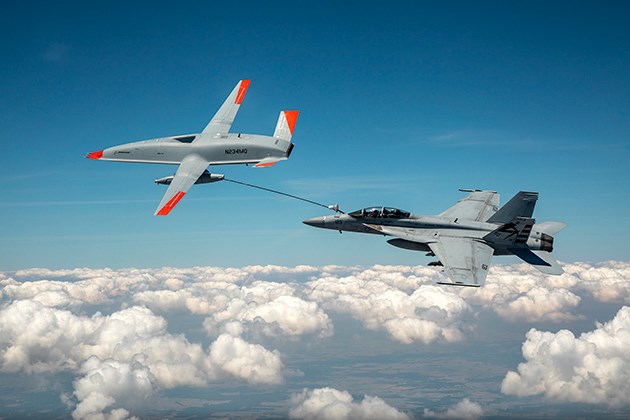U.S. Navy, Boeing conduct first aerial refueling with unmanned aircraft
The composites-intensive MQ-25 successfully transferred jet fuel to a U.S. Navy F/A-18 Super Hornet mid-air.

The Boeing MQ-25 T1 test asset transfers fuel to a U.S. Navy F/A-18 Super Hornet June 4, which is said to mark the first time in history that an unmanned aircraft has refueled another aircraft. Photo Credit: Kevin Flynn
Boeing (Chicago, Ill., U.S.) reported on June 7 that for the first time, the U.S. Navy and Boeing have demonstrated air-to-air refueling using an unmanned aircraft — the Boeing-owned, composites-intensive MQ-25 T1 test asset — to refuel another aircraft.
During a test flight June 4, MQ-25 T1 successfully extended the hose and drogue from its U.S. Navy-issued aerial refueling store (ARS) and safely transferred jet fuel to a U.S. Navy F/A-18 Super Hornet, demonstrating the MQ-25 Stingray’s ability to carry out its primary aerial refueling mission.
“This team of professionals was integral in the successful flight,” says Rear Adm. Brian Corey, who oversees the Program Executive Office for Unmanned Aviation and Strike Weapons. “Over the next few years, we will work side-by-side with Boeing to deliver this capability that will greatly enhance the future carrier air wing.”
“This history-making event is a credit to our joint Boeing and Navy team that is all-in on delivering MQ-25’s critical aerial refueling capability to the fleet as soon as possible,” adds Leanne Caret, president and CEO of Boeing Defense, Space & Security. “Their work is the driving force behind the safe and secure integration of unmanned systems in the immediate future of defense operations.”
During the initial part of the flight, the F/A-18 test pilot flew in close formation behind MQ-25 to ensure performance and stability prior to refueling — a maneuver that required as little as 20 feet of separation between the MQ-25 T1 air vehicle and the F/A-18 refueling probe. Both aircraft were flying at operationally relevant speeds and altitudes. With the evaluation safely completed, the MQ-25 drogue was extended, and the F/A-18 pilot moved in to “plug” with the unmanned aircraft and receive the scheduled fuel offload.
The milestone comes after 25 T1 flights, testing both aircraft and ARS aerodynamics across the flight envelope, as well as extensive simulations of aerial refueling using MQ-25 digital models. Boeing says the MQ-25 T1 will continue flight testing prior to being shipped to Norfolk, Va., for deck handling trials aboard a U.S. Navy carrier later this year.
The Boeing-owned T1 test asset is a predecessor to the seven test aircraft Boeing is manufacturing under a 2018 contract award. The MQ-25 will assume the tanking role currently performed by F/A-18s, allowing for better use of the combat strike fighters and helping extend the range of the carrier air wing.
MQ-25 is a trademark of the Department of the Navy.
Related Content
-
TenCate Advanced Armour renamed to Integris Composites
With its rebranding, Integris maintains the ability to develop, test and manufacture ballistic armor and survivability solutions while expanding into new markets where composite solutions can be advantageous.
-
Large-format 3D printing enables toolless, rapid production for AUVs
Dive Technologies started by 3D printing prototypes of its composite autonomous underwater vehicles, but AM became the solution for customizable, toolless production.
-
Industrializing additive manufacturing in the defense/aerospace sector
GA-ASI demonstrates a path forward for the use of additive technologies for composite tooling, flight-qualified parts.
















